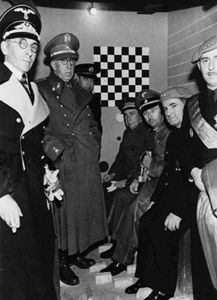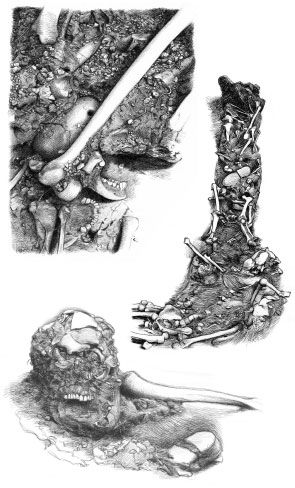The Spanish Holocaust (102 page)
Read The Spanish Holocaust Online
Authors: Paul Preston
Tags: #Non-Fiction, #Military History, #20th Century, #European History, #21st Century, #Amazon.com, #Retail, #Spain, #History

Antonio Vallejo-Nájera, head of Franco’s psychiatric services. He conducted experiments on prisoners to identify the ‘red gene’.

Himmler visits the psycho-technic checa of Alfonso Laurencic in Barcelona.

Drawings made by Simon Manfield during the excavation at Valdedios, Asturias, summer 2003.
Acción Popular (briefly known as Acción Nacional): ‘an organization for social defence’ created in 1931 by Ángel Herrera Oria, the editor of
El Debate
, in response to the coming of the Second Republic. It would be the nucleus of the CEDA (q.v.)
Africanistas: Spanish army officers experienced in, and often brutalized by, the colonial war in Morocco
Agrupación Nacional de Propietarios de Fincas Rústicas: National Association of Rural Estate-Owners
alcalde
: mayor
ANCP: Asociación Católica Nacional de Propagandistas – an elite Jesuit-influenced organization of about five hundred prominent and talented Catholic rightists with influence in the press, the judiciary and the professions
Ayuntamiento: town council and also the town hall
bracero
: unskilled agricultural labourer hired by the day
cacique
: a powerful rural boss, usually a landowner but sometimes a money-lender or both
Casa del Pueblo: the main gathering place for the local left wing, sometimes a kind of club, sometimes the headquarters of parties and unions
casino
: the main gathering place for the local right wing
Caudillo: literally bandit chieftain, more usually military leader, became Franco’s title, the equivalent of Hitler’s ‘Führer’ or Mussolini’s ‘Duce’
CCMA: Comitè Central de les Milícies Antifeixistes de Catalunya – Central Anti-Fascist Militia Committee, the executive body created on 20 July 1936 to combine the Generalitat (q.v.) and representatives of all the democratic and left-wing forces in Catalonia. It never functioned efficiently and within months the Generalitat had re-established its power
CEDA: Confederación Española de Derechas Autónomas – Spanish Confederation of Autonomous Right-Wing Groups, the principal mass party of the right, created in 1933, led by José María Gil Robles
checas
: autonomous police forces and detention centres created in July 1936 in the Republican zone by working-class unions and parties
Civil Governor: the principal authority in any province, appointed by the Ministry of the Interior
CNCA: Confederación Nacional Católico-Agraria – National Catholic Agrarian Confederation, conservative association of smallholders created in 1917. It provided mass support for the CEDA
CNT: Confederación Nacional del Trabajo – National Confederation of Labour, anarcho-syndicalist trade union founded in 1910
CPIP: Comité Provincial de Investigación Pública – Provincial Committee of Public Investigation, created in August 1936 by the Republican Ministry of the Interior in an attempt to control the
checas
(q.v.) of the left-wing parties and trade unions
DEDIDE: Departamento Especial de Información del Estado – State Special Intelligence Department, created in June 1937 to centralize the Republican security and counter-espionage services
DERD: Delegación del Estado para la Recuperación de Documentos – State Delegation for the Recovery of Documents, the Francoist entity created in April 1938 to classify captured documentation from left-wing and liberal political parties, organizations and individuals in order to facilitate their location and punishment
DGS: Dirección General de Seguridad – General Directorate of Security, the national headquarters of the police and security forces
DRV: Derecha Regional Valenciana – the right-wing group of the Valencian region, one of the principal component groups that made up the CEDA (q.v.)
ERC: Esquerra Republicana de Catalunya – the Republican Left of Catalonia, the principal Catalan nationalist party, led by Lluís Companys
FAI: Federación Anarquista Ibérica – Iberian Anarchist Federation, the activist or terrorist wing of the anarchist movement founded in 1927
Falange Española: Spanish fascist party founded by José Antonio Primo de Rivera in October 1933
FE de las JONS: Falange Española de las Juntas de Ofensiva Nacional Sindicalista – the Spanish fascist party created by the merger in February 1934 of the Falange and the JONS (q.v.)
FJS: Federación de Juventudes Socialistas – the youth movement of the Socialist Party, PSOE (q.v.)
FNTT: Federación Nacional de Trabajadores de la Tierra – the Socialist landworkers’ union affiliated to the UGT (q.v.)
Frente Popular: Popular Front, wide electoral coalition created in November 1935. It replicated the Republican–Socialist coalition of 1931 with the addition of three small groups – the Spanish Communist Party, the more or less Trotskyist POUM (q.v.) and the Syndicalist Party of the moderate anarchist Ángel Pestaña
Generalitat de Catalunya: the Catalan regional government, established by the autonomy statute of 1932
GRU: Glavnoye Razvedyvatel’noye Upravleniye – Soviet military intelligence
Izquierda Republicana: the Republican Left, the liberal party formed on 2 April 1934 from the merger of three other Republican groups and led by Manuel Azaña
JAP: Juventud de Acción Popular – the youth movement of the CEDA (q.v.)
JONS: Juntas de Ofensiva Nacional Sindicalista – the Juntas of National-Syndicalist Offensive, a tiny but violent fascist group founded by Onésimo Redondo and Ramiro Ledesma Ramos, who provided Spain’s fascist insignia, the yoke and the arrows
jornalero
: agricultural labourer, paid by the day worked
JSU: Juventudes Socialistas Unificadas – the United Socialist Youth, closely linked to the PCE (q.v.) after it was created in mid-1936 from the fusion of the Socialist and Communist youth movements
KGB: Komitet Gosudarstvennoy Bezopasnosti – Committee for State Security, the Soviet security and intelligence organization, the successor to the NKVD (q.v.)
latifundio
: a huge estate found principally in Andalusia and Extremadura
latifundista
: the owner of such an estate
Legionario: soldier of the Spanish Foreign Legion or Tercio de Extranjeros (q.v.)
NKVD: Narodnyy Komissariat Vnutrennikh Del – the People’s Commissariat for Internal Affairs, Soviet security and intelligence organization
ORD: Oficina de Recuperación de Documentos – Office for the Recovery of Documents, set up on Franco’s orders in May 1937 by the Carlist Marcelino de Ulibarri Eguílaz
OVRA: Organizzazione per la Vigilanza e la Repressione dell’Antifascismo – Italian fascist secret police
paseo
: taking prisoners for a ride, slang for extra-judicial execution
PCE: Partido Comunista de España – Spanish Communist Party
PNV: Partido Nacionalista Vasco – the conservative and Catholic Basque Nationalist Party which sided with the Republic in 1936
POUM: Partido Obrero de Unificación Marxista – Workers’ Marxist Unification Party, founded in late 1935, with the intention of uniting all left-wing forces into a revolutionary communist party opposed to Stalinism and therefore closer to Trotskyism
PSOE: Partido Socialista Obrero Español – the Spanish Socialist Workers Party
PSUC: Partit Socialista Unificat de Catalunya – the Catalan Communist Party
pueblo
: small town or village
Regulares Indígenas: Native Regulars, a section of the Spanish colonial army consisting of tribal mercenaries recruited in Morocco
Renovación Española: Spanish Renovation – the extremist monarchist party
Requeté: the Carlist militia. The word denotes both an individual militiaman and the entire corps
ROVS: Russkii Obshche-Voinskii Soiuz – Russian All-Military Union, White Russian anti-Bolshevik organization in Paris with which General Emilio Mola had close ties
saca
: the seizing and murder of an individual
SIM: Servicio de Inteligencia Militar – military intelligence service
Tercio de Extranjeros: the Spanish Foreign Legion created on 31 August 1920 (
tercio
, or third, was the name used in the sixteenth century for regiments in the Army of Flanders which had been composed of three groups, pikemen, crossbowmen and arquebusiers)
UGT: Unión General de Trabajadores – the General Union of Workers, Socialist trade union which incorporated many specialized unions of railway, building and other workers
UHP: Uníos, Hermanos Proletarios – Unite, Proletarian Brothers, a slogan coined during the Asturian rising of October 1934 and thereafter used as a chant and as graffiti
UME: Unión Militar Española – clandestine association of army officers devoted to the overthrow of the Republic, created in late 1933 by the retired Colonel Emilio Rodríguez Tarduchy, one of the first members of the Falange Española
UMRA: Unión Militar Republicana Antifascista – organization of Republican army officers committed to foiling the conspiratorial activities of the UME (q.v.). It was founded in late 1935 by Captain Eleuterio Díaz-Tendero Merchán, who would later die in Dachau
yuntero
: ploughman owning his own yoke of oxen, usually hired on the same basis as a
jornalero
Prologue
1 Comandante Franco,
Diario de una bandera
(Madrid: Editorial Pueyo, 1922) pp. 129, 177.
2
El Correo Gallego
, 20 April 1922.
3 José Martín Blázquez,
I Helped to Build an Army: Civil War Memoirs of a Spanish Staff Officer
(London: Secker & Warburg, 1939) p. 302; Herbert R. Southworth,
Antifalange: estudio crítico de ‘Falange en la guerra de España: la Unificación y Hedilla’ de Maximiano García Venero
(Paris: Ruedo Ibérico, 1967) pp. xxi–xxii; Guillermo Cabanellas,
La guerra de los mil días: nacimiento, vida y muerte de la II República española
, 2 vols (Buenos Aires: Grijalbo, 1973) II, p. 792.
4 Juan de Iturralde (Father Juan José Usabiaga Irazustabarrena),
La guerra de Franco, los vascos y la Iglesia
, 2 vols (San Sebastián: Publicaciones del Clero Vasco, 1978) I, p. 433.
5 The most widely accepted figure for Madrid is 8,815. See Santos Juliá
et al.
,
Víctimas de la guerra civil
(Madrid: Ediciones Temas de Hoy, 1999) p. 412; Mirta Núñez Díaz-Balart
et al.
,
La gran represión: los años de plomo del franquismo
(Barcelona: Flor del Viento, 2009) p. 443; and José Luis Ledesma, ‘Una retaguardia al rojo: las violencias en la zona republicana’, in Francisco Espinosa Maestre, ed.,
Violencia roja y azul: España, 1936–1950
(Barcelona: Editorial Crítica, 2010) pp. 247, 409. The figure of 8,815 is based on that of 5,107 given by General Rafael Casas de la Vega,
El terror: Madrid 1936: investigación histórica y catálogo de víctimas identificadas
(Madrid: Editorial Fénix, 1994) pp. 247, 311–460, to which, without explanation, 3,708 were added by Ángel David Martín Rubio,
Paz, piedad, perdón … y verdad: la represión en la guerra civil: una síntesis definitiva
(Madrid: Editorial Fénix, 1997) p. 316. In the same work pp. 317–19, 370, 374, and in
Los mitos de la represión en la guerra civil
(Madrid: Grafite Ediciones, 2005) p. 82, Martín Rubio gives the figure of 14,898, again without explanation.
Other books
When I Wasn't Watching by Michelle Kelly
Witch Is The New Black by Dakota Cassidy
The Brotherhood of the Snake (Return of the Ancients Book 2) by Carmen Caine, Madison Adler
The Adamantine Palace by Stephen Deas
Somewhere in Sevenoakes by Sorell Oates
(18/20) Changes at Fairacre by Read, Miss
Playground by Jennifer Saginor
Scam on the Cam by Clémentine Beauvais
Oceans of Fire by Christine Feehan
